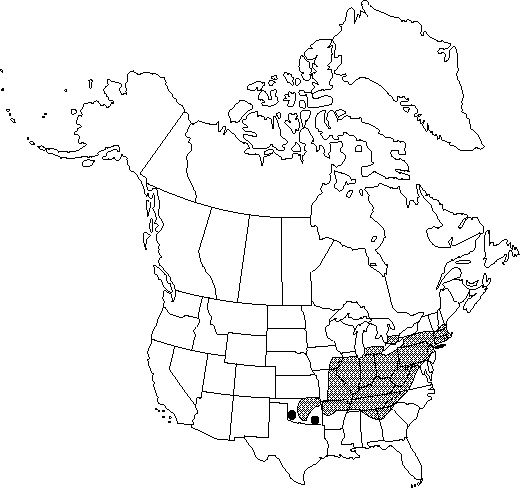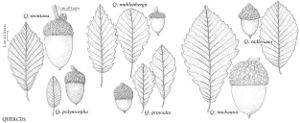Difference between revisions of "Quercus prinoides"
in G. H. E. Muhlenberg, Ges. Naturf. Freunde Berlin Neue Schriften 3: 397. 1801.
FNA>Volume Importer |
FNA>Volume Importer |
||
| Line 13: | Line 13: | ||
}}{{Treatment/ID/Special_status | }}{{Treatment/ID/Special_status | ||
|code=F | |code=F | ||
| − | |label= | + | |label=Illustrated |
}} | }} | ||
|basionyms= | |basionyms= | ||
| Line 19: | Line 19: | ||
|name=Quercus prinoides var. rufescens | |name=Quercus prinoides var. rufescens | ||
|authority=Rehder | |authority=Rehder | ||
| + | |rank=variety | ||
}} | }} | ||
|hierarchy=Fagaceae;Quercus;Quercus sect. Quercus;Quercus prinoides | |hierarchy=Fagaceae;Quercus;Quercus sect. Quercus;Quercus prinoides | ||
| Line 36: | Line 37: | ||
|discussion=<p>Some reports of <i>Quercus prinoides</i> growing in calcareous soils are probably referable to shrub forms of Q. muhlenbergii.</p><!-- | |discussion=<p>Some reports of <i>Quercus prinoides</i> growing in calcareous soils are probably referable to shrub forms of Q. muhlenbergii.</p><!-- | ||
--><p>The debate over whether <i>Quercus prinoides</i> is distinct from Q. muhlenbergii has continued for most of the last century. Little doubt can exist that strong genetic differences, as expressed by characteristics of habit, leaf form, and habitat preference, separate the two taxa; the question is merely whether they are best treated as subspecies or varieties or as separate species. Over most of the eastern United States, the two taxa occur sympatrically over broad areas with little immediate contact (syntopy), because Q. muhlenbergii is found on calcareous soils and <i>Q. prinoides</i> occurs on sands (often acidic) and dry shales. Seedlings of <i>Q. prinoides</i> can flower and produce acorns in as few as 3-5 years from planting, when only 20-50 cm, and maintain their dwarf, clonal habit in cultivation. <i>Quercus</i> muhlenbergii begins fruiting as a small tree of 3 m or more in height. Because of these differences, and interdigitating geographic distributions, the two taxa seem to be similar in pattern of variation and interaction to other closely related oak species of eastern North America, and dissimilar in pattern to infraspecific taxa such as we see in <i>Q. sinuata </i>var.<i> sinuata</i> and <i>Q. sinuata </i>var.<i> breviloba</i>. The populations that are difficult to determine are usually small scrubby trees, probably mostly Q. muhlenbergii, stunted because of less than favorable moisture conditions, with or without indications of introgression from <i>Q. prinoides</i>.</p><!-- | --><p>The debate over whether <i>Quercus prinoides</i> is distinct from Q. muhlenbergii has continued for most of the last century. Little doubt can exist that strong genetic differences, as expressed by characteristics of habit, leaf form, and habitat preference, separate the two taxa; the question is merely whether they are best treated as subspecies or varieties or as separate species. Over most of the eastern United States, the two taxa occur sympatrically over broad areas with little immediate contact (syntopy), because Q. muhlenbergii is found on calcareous soils and <i>Q. prinoides</i> occurs on sands (often acidic) and dry shales. Seedlings of <i>Q. prinoides</i> can flower and produce acorns in as few as 3-5 years from planting, when only 20-50 cm, and maintain their dwarf, clonal habit in cultivation. <i>Quercus</i> muhlenbergii begins fruiting as a small tree of 3 m or more in height. Because of these differences, and interdigitating geographic distributions, the two taxa seem to be similar in pattern of variation and interaction to other closely related oak species of eastern North America, and dissimilar in pattern to infraspecific taxa such as we see in <i>Q. sinuata </i>var.<i> sinuata</i> and <i>Q. sinuata </i>var.<i> breviloba</i>. The populations that are difficult to determine are usually small scrubby trees, probably mostly Q. muhlenbergii, stunted because of less than favorable moisture conditions, with or without indications of introgression from <i>Q. prinoides</i>.</p><!-- | ||
| − | --><p>Material of <i>Quercus prinoides</i> from Long Island, coastal Massachusetts, Nantucket Island, and Martha's Vineyard has been segregated as <i>Q. prinoides</i> Willdenow < | + | --><p>Material of <i>Quercus prinoides</i> from Long Island, coastal Massachusetts, Nantucket Island, and Martha's Vineyard has been segregated as <i>Q. prinoides</i> Willdenow <i></i>var.<i> rufescens</i> Rehder on the basis of vestiture and minor differences in leaf form. These populations have appressed-stellate leaf pubescence abaxially, as throughout the range of the species; in addition they have reddish, erect, fasiculate hairs similar to those found in <i>Q. michauxii</i>. The hairs make the abaxial leaf surface somewhat felty to the touch. Variability in this characteristic and lack of other consistently correlated features preclude taxonomic recognition of <i>Q. prinoides</i> <i></i>var.<i> rufescens</i>, but this problem is worthy of further investigation.</p> |
|tables= | |tables= | ||
|references= | |references= | ||
| Line 45: | Line 46: | ||
-->{{#Taxon: | -->{{#Taxon: | ||
name=Quercus prinoides | name=Quercus prinoides | ||
| − | |||
|authority=Willdenow in G. H. E. Muhlenberg | |authority=Willdenow in G. H. E. Muhlenberg | ||
|rank=species | |rank=species | ||
| Line 59: | Line 59: | ||
|publication title=in G. H. E. Muhlenberg, Ges. Naturf. Freunde Berlin Neue Schriften | |publication title=in G. H. E. Muhlenberg, Ges. Naturf. Freunde Berlin Neue Schriften | ||
|publication year=1801 | |publication year=1801 | ||
| − | |special status=Endemic; | + | |special status=Endemic;Illustrated |
| − | |source xml=https://jpend@bitbucket.org/aafc-mbb/fna-data-curation.git/src/ | + | |source xml=https://jpend@bitbucket.org/aafc-mbb/fna-data-curation.git/src/f50eec43f223ca0e34566be0b046453a0960e173/coarse_grained_fna_xml/V3/V3_920.xml |
|genus=Quercus | |genus=Quercus | ||
|section=Quercus sect. Quercus | |section=Quercus sect. Quercus | ||
Revision as of 21:32, 16 December 2019
Shrubs, deciduous, (0.5-)1-3(-5, 10?) m, sometimes spreading-rhizomatous. Bark gray, thin, flaky to papery. Twigs brownish, 1.5-3(-4) mm diam., sparsely fine-pubescent, soon becoming glabrate, graying in 2d year. Buds brown to red-brown, subrotund to broadly ovoid, 1-3 mm, apex rounded, very sparsely pubescent. Leaves: petiole (7-)8-15(-25) mm. Leaf blade lanceolate to oblanceolate or usually obovate, 40-140 × 20-60(-80) mm, leathery, base truncate to cuneate, margins regularly undulate, toothed or shallow-lobed, teeth usually acute, sometimes rounded, or acute-acuminate, often strongly antrorse, secondary veins usually 5-8(-9) on each side, ± parallel, apex short-acute to acuminate; surfaces abaxially glaucous or light green, appearing glabrate, with scattered or crowded minute, appressed, symmetric, 6-10-rayed, stellate hairs, adaxially lustrous dark green, glabrate. Acorns solitary or paired, subsessile or on axillary peduncle to 3-8 mm; cup deeply or shallowly cup-shaped, 9-12 mm deep × 13-17(-22) mm wide, enclosing 1/4-1/3 nut, base rounded, margin usually thin, scales rather tightly appressed, moderately tuberculate, uniformly short gray-pubescent; nut light brown, oblong to ovoid, (13-)15-20 × 10-13 mm. Cotyledons distinct.
Phenology: Flowering in spring.
Habitat: Pine barrens, scrublands, forest margins, prairies, and exposed ridges, on deep sands or dry shale, rarely reported on calcareous soils
Elevation: 0-500 m
Distribution

Ont., Ala., Ark., Conn., Ga., Ill., Ind., Iowa, Ky., Mass., Mich., Mo., N.H., N.J., N.Y., N.C., Ohio, Okla., Pa., R.I., S.C., Tenn., Vt., Va., W.Va.
Discussion
Some reports of Quercus prinoides growing in calcareous soils are probably referable to shrub forms of Q. muhlenbergii.
The debate over whether Quercus prinoides is distinct from Q. muhlenbergii has continued for most of the last century. Little doubt can exist that strong genetic differences, as expressed by characteristics of habit, leaf form, and habitat preference, separate the two taxa; the question is merely whether they are best treated as subspecies or varieties or as separate species. Over most of the eastern United States, the two taxa occur sympatrically over broad areas with little immediate contact (syntopy), because Q. muhlenbergii is found on calcareous soils and Q. prinoides occurs on sands (often acidic) and dry shales. Seedlings of Q. prinoides can flower and produce acorns in as few as 3-5 years from planting, when only 20-50 cm, and maintain their dwarf, clonal habit in cultivation. Quercus muhlenbergii begins fruiting as a small tree of 3 m or more in height. Because of these differences, and interdigitating geographic distributions, the two taxa seem to be similar in pattern of variation and interaction to other closely related oak species of eastern North America, and dissimilar in pattern to infraspecific taxa such as we see in Q. sinuata var. sinuata and Q. sinuata var. breviloba. The populations that are difficult to determine are usually small scrubby trees, probably mostly Q. muhlenbergii, stunted because of less than favorable moisture conditions, with or without indications of introgression from Q. prinoides.
Material of Quercus prinoides from Long Island, coastal Massachusetts, Nantucket Island, and Martha's Vineyard has been segregated as Q. prinoides Willdenow var. rufescens Rehder on the basis of vestiture and minor differences in leaf form. These populations have appressed-stellate leaf pubescence abaxially, as throughout the range of the species; in addition they have reddish, erect, fasiculate hairs similar to those found in Q. michauxii. The hairs make the abaxial leaf surface somewhat felty to the touch. Variability in this characteristic and lack of other consistently correlated features preclude taxonomic recognition of Q. prinoides var. rufescens, but this problem is worthy of further investigation.
Selected References
None.
